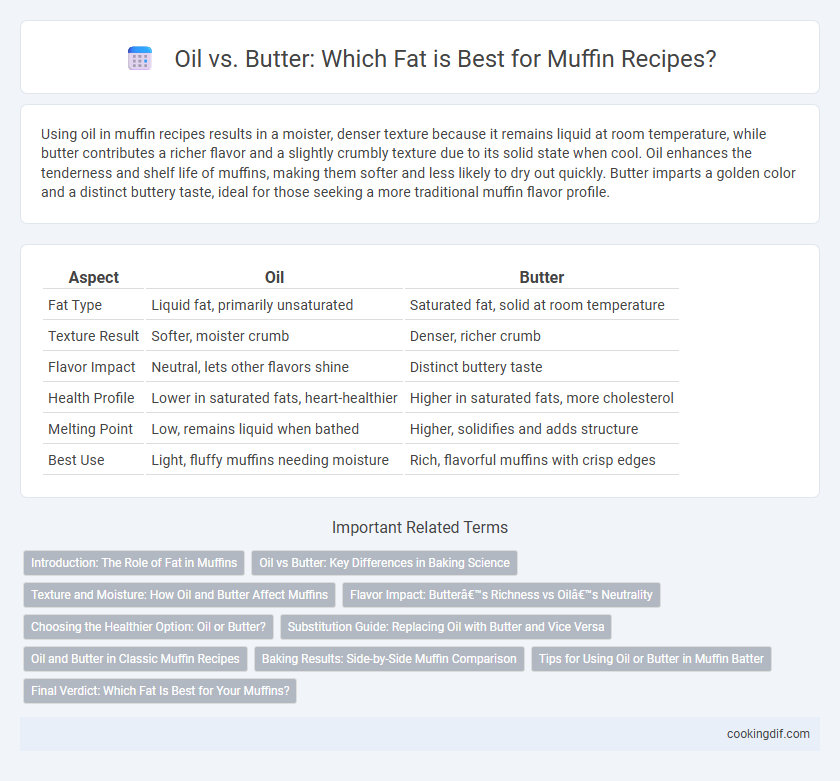Using oil in muffin recipes results in a moister, denser texture because it remains liquid at room temperature, while butter contributes a richer flavor and a slightly crumbly texture due to its solid state when cool. Oil enhances the tenderness and shelf life of muffins, making them softer and less likely to dry out quickly. Butter imparts a golden color and a distinct buttery taste, ideal for those seeking a more traditional muffin flavor profile.
Table of Comparison
| Aspect | Oil | Butter |
|---|---|---|
| Fat Type | Liquid fat, primarily unsaturated | Saturated fat, solid at room temperature |
| Texture Result | Softer, moister crumb | Denser, richer crumb |
| Flavor Impact | Neutral, lets other flavors shine | Distinct buttery taste |
| Health Profile | Lower in saturated fats, heart-healthier | Higher in saturated fats, more cholesterol |
| Melting Point | Low, remains liquid when bathed | Higher, solidifies and adds structure |
| Best Use | Light, fluffy muffins needing moisture | Rich, flavorful muffins with crisp edges |
Introduction: The Role of Fat in Muffins
Fat plays a crucial role in muffin recipes by influencing texture, moisture, and flavor. Butter provides a rich, creamy taste and contributes to a tender crumb, while oil generally produces a moister, denser muffin with a softer bite. Choosing between oil and butter affects the muffin's overall quality and shelf life, making it essential to understand their distinct properties in baking.
Oil vs Butter: Key Differences in Baking Science
Oil creates moister and denser muffins due to its liquid state at room temperature, while butter contributes to a lighter, fluffier texture by trapping air when creamed with sugar. Butter's milk solids also enhance flavor complexity and promote browning through the Maillard reaction, whereas oil imparts a neutral taste and results in softer crumb. Choosing between oil and butter impacts muffin tenderness, flavor profile, and shelf life, with oil-based muffins generally staying fresher longer.
Texture and Moisture: How Oil and Butter Affect Muffins
Oil in muffin recipes creates a moister and softer texture because it remains liquid at room temperature, keeping the crumb tender and more elastic. Butter contributes a richer flavor and a slightly denser, flakier texture due to its solid fat content, which traps air during creaming and adds structure. Choosing oil results in a tender, moist muffin, while butter offers a buttery taste with a more structured crumb.
Flavor Impact: Butter’s Richness vs Oil’s Neutrality
Butter imparts a rich, creamy flavor to muffins, enhancing their overall taste and creating a tender crumb with a slightly caramelized crust. Oil contributes a neutral taste, allowing other flavors to stand out while producing a moist, denser texture. Choosing butter over oil prioritizes flavor complexity, while oil emphasizes softness and subtlety in muffins.
Choosing the Healthier Option: Oil or Butter?
Choosing between oil and butter for fats in muffin recipes hinges on health benefits and baking outcomes; oil, particularly olive or canola, offers unsaturated fats that support heart health and create moist, tender muffins. Butter, while providing rich flavor and a desirable crumb structure due to saturated fats, contains cholesterol and higher calories that may impact cardiovascular health if consumed excessively. Opting for oils with healthy fat profiles can improve the nutritional value of muffins without sacrificing texture.
Substitution Guide: Replacing Oil with Butter and Vice Versa
When substituting oil with butter in muffin recipes, use a 1:1 ratio but melt the butter to match oil's liquid state for consistent batter texture. Replacing butter with oil requires reducing the amount by about 20% since oil is 100% fat, while butter contains water and milk solids. Butter adds richer flavor and a denser crumb, whereas oil produces moister, lighter muffins with a more neutral taste.
Oil and Butter in Classic Muffin Recipes
Oil in classic muffin recipes provides a moist, tender crumb due to its liquid state at room temperature, enhancing texture without altering flavor significantly. Butter contributes a rich, distinctive taste and a slightly denser texture because it solidifies when cooled, which can create a more structured muffin. Choosing between oil and butter depends on the desired balance of moistness and flavor intensity in the final muffin.
Baking Results: Side-by-Side Muffin Comparison
Muffins made with oil tend to have a moister and denser texture compared to those baked with butter, which produce a richer flavor and a slightly firmer crumb. Oil-based muffins often retain moisture longer, making them ideal for extended shelf life, while butter enhances browning and adds a subtle complexity to the taste. Baking tests show that oil creates a more tender crumb, but butter leads to a more golden, flavorful crust in muffin recipes.
Tips for Using Oil or Butter in Muffin Batter
Using oil in muffin batter yields moist, tender crumb due to its liquid state at room temperature, making it ideal for dense, rich muffins; measure oil precisely to avoid overly greasy texture. Butter contributes a rich flavor and slightly firmer crumb from solid fats, so melt it before incorporation for even distribution and better rise. For optimal results, balance flavor and texture by combining softened butter with a small amount of oil, enhancing moisture retention while preserving buttery taste.
Final Verdict: Which Fat Is Best for Your Muffins?
Butter provides rich flavor and a tender crumb in muffin recipes due to its water content and milk solids, creating a moist, flavorful texture. Oil yields a moister, denser muffin with a soft crumb, ideal for fruity or vegetable-based muffins where pronounced butter flavor is less critical. Choosing butter results in classic taste and structure, while oil enhances moistness and shelf life, making the best fat dependent on your desired muffin texture and flavor profile.
Oil vs Butter for fat in muffin recipes Infographic

 cookingdif.com
cookingdif.com